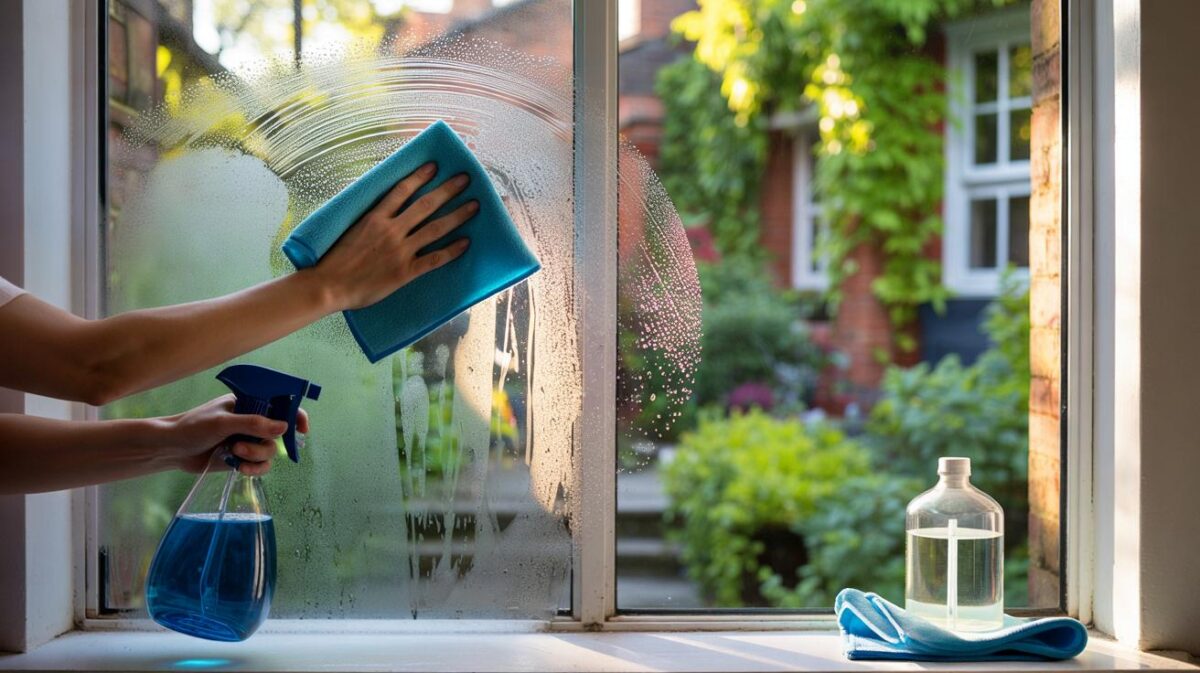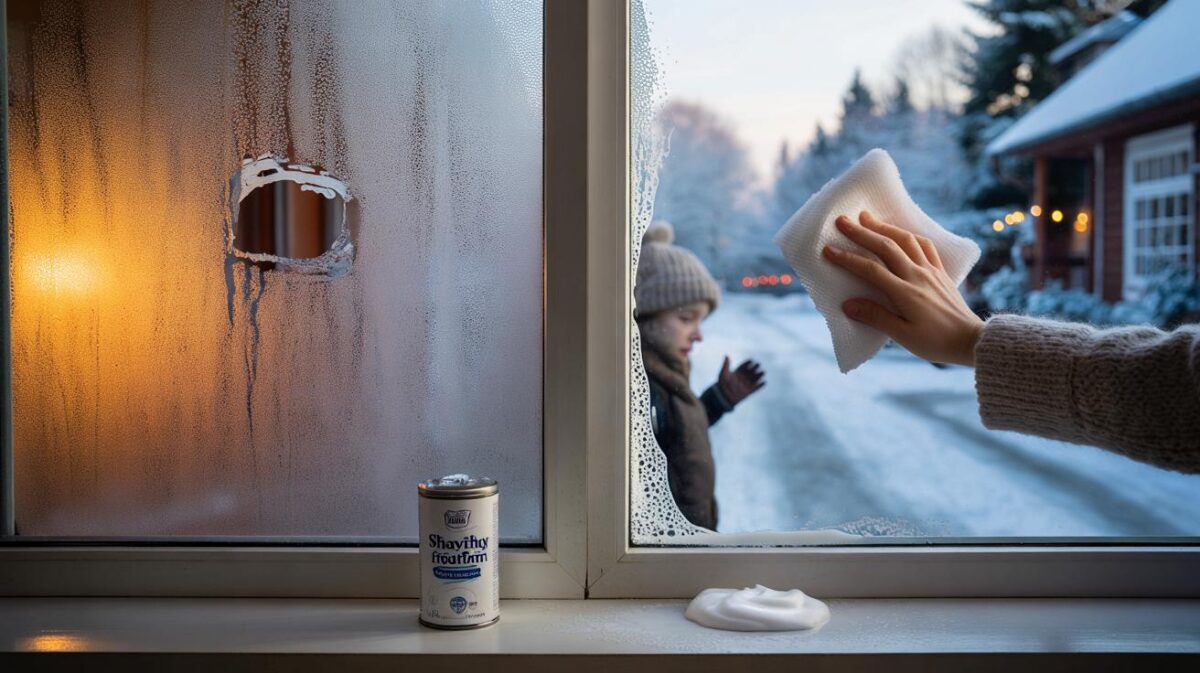You try sprays, you try elbow grease, yet the haze creeps back. There’s a £1 fix most professionals quietly rely on that keeps glass crisp through rain, steam, and hard water. It isn’t a fancy bottle. It’s a humble helper hiding under your sink.
I noticed it on a grey Saturday in Brighton, the kind where light is thin and every streak announces itself. A neighbour across the courtyard moved like a drummer with a rhythm, swipe-swipe-swipe, and his panes flashed clean in seconds. No clouds, no drag marks, just clear. He had a bucket, a small squeegee, and a plain, unbranded bottle with a blue sheen. When he saw me gawping, he grinned and held it up: dishwasher rinse aid, the cheap supermarket one. One teaspoon, he said, and the window becomes easy. The secret cost a pound.
Why your windows keep fighting you
Glass doesn’t get dirty in a single way, which is why a single spray rarely solves it. Rain dries in dots because water clings to micro-texture, leaving mineral rings. Central heating throws dust, then condensation glues it to the pane. Coastal air leaves salt smears; urban air leaves fine oily film. All of that gets set by sunlight into a faint glaze. The streaks you see are not just dirt. They’re surface tension telling you who’s boss.
Ask a veteran window cleaner and they’ll talk more about water than about cloths. In Leeds, I shadowed Dave, who does 40 terraces a week with a waist bucket and the patience of a gardener. He works in drizzle, in pollen season, through that September leaf-mould smell. He doesn’t carry half a shop’s worth of sprays. He carries one small bottle of supermarket rinse aid, £1 on offer, and says it cuts his time by about a fifth. “It’s the slip,” he shrugs. “Water behaves.” A single bottle lasts him a month.
The reason is more chemistry than mystique. Rinse aid is built to break water tension so plates dry without spots. On glass, the same non-ionic surfactants make water spread into a thin sheet instead of beads. No beads, fewer rings. Fewer rings, fewer passes. That thin film also helps your squeegee glide without chatter, which is where most streaks are born. You’re not just cleaning; you’re persuading water to leave quietly. In spring with pollen, in summer with sprinkler spray, in winter with salty mist, the effect holds.
The £1 method the pros actually use
Here’s the simple mix dozens of pros quietly swear by: 1 litre of warm water, 1 teaspoon of dishwasher rinse aid, and, if your panes are very greasy, a tiny drop of washing-up liquid. Dip a microfibre applicator or a soft cloth, wash top to bottom, then squeegee in straight lines with a dry blade edge. Wipe the blade on a towel between each pass. Finish with a quick buff of a dry microfibre on the edges and corners. For shower screens or car glass, you can wipe a 1:10 rinse-aid-and-water mix on, leave 30 seconds, then buff off for a beading, spot-resistant finish. *That’s it.*
The trap is thinking more product equals more shine. It doesn’t. Overdose the rinse aid and you’ll leave a film that smears. Under-rinse a cloth and you’ll drag grit. Go gentle: teaspoon, not capful. Use soft water if you can (kettle-boiled and cooled, or distilled for the particular). Keep your blade clean, and swap it when the edge nicks. We’ve all had that moment when you clean for ten minutes, step back, and the low sun laughs at you. Let the mix do the heavy lifting. Let’s be honest: no one really does this every day.
Rinse aid is glass-safe, yet a little care goes a long way. If you have aftermarket window film or tinted car glass, test a corner first. Avoid letting the mix sit on painted frames or natural stone sills for long; wipe stray drips promptly. If your water is very hard, finish with a quick dry buff.
“You’re not polishing the glass,” says Amira, who services hotel atriums in Manchester. “You’re polishing the water so it leaves no trace.”
Here’s a pocket checklist that keeps the rhythm flowing:
- 1 litre warm water + 1 teaspoon rinse aid
- Apply, then squeegee straight lines, wiping the blade each pass
- Dry-buff edges with a clean microfibre
- Use soft water for final passes in hard-water areas
- Test films/tints in an inconspicuous corner
What changes when water behaves
When water sheets, everything speeds up. You do fewer corrective swipes. You don’t chase ghost smears as the sun drops. Outside panes stay clearer after showers because droplets slide before they dry. Shower screens take longer to fog, and mirrors shrug off those milky arcs after hot baths. It won’t stop dust or children’s fingerprints, but the reset is quicker and the shine lasts longer. Suddenly, the weekly clean becomes the fortnightly tidy.
| Point clé | Détail | Intérêt pour le lecteur |
|---|---|---|
| Rinse aid mix | 1 litre warm water + 1 teaspoon rinse aid | Fast, streak-free results with a £1 product |
| Technique | Apply, straight squeegee passes, wipe blade every time | Cleaner panes in fewer moves |
| All-season edge | Helps against rain spots, shower film, salty mist | Longer-lasting clarity whatever the weather |
FAQ :
- Can I just use vinegar instead?Vinegar cuts mineral deposits, which is great for limescale, but it doesn’t give the same sheeting and slip. A teaspoon of rinse aid in water gives faster drying and fewer streaks. You can use both: a vinegar wash to de-scale, then the rinse-aid mix for the finish.
- Is rinse aid safe on car windscreens?Yes for glass. Keep it off paint and wiper rubbers as a habit, and don’t overdo it. Apply the diluted mix, buff dry, then run wipers to clear any residue before driving. If you use a rain-repellent coating, test compatibility first.
- How long does the effect last?On exterior windows, you’ll notice easier cleaning and fewer spots for a couple of weeks in typical UK weather. On shower glass, the beading can last several showers. It’s not a permanent coating; it just tilts the game in your favour.
- Will it damage window tints or films?Factory tints in glass are fine. Aftermarket films vary. Do a small test patch and use a very light mix. If you see any clouding or edge lift, stop and stick to a neutral glass cleaner and water.
- What if my water is very hard?Use kettle-boiled, cooled water or distilled for the final passes. The rinse aid helps, but hard water minerals still dry as spots. A soft final rinse and a dry microfibre buff keep edges crisp.








